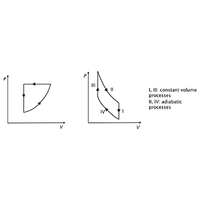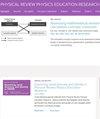Investigating introductory and advanced students’ difficulties with entropy and the second law of thermodynamics using a validated instrument
IF 3.6
2区 教育学
Q1 EDUCATION & EDUCATIONAL RESEARCH
Physical Review Physics Education Research
Pub Date : 2024-08-19
DOI:10.1103/physrevphyseducres.20.020110
引用次数: 0
Abstract
We use the Survey of Thermodynamic Processes and First and Second Laws-Long (STPFaSL-Long), a research-based survey instrument with 78 items at the level of introductory physics, to investigate introductory and advanced students’ difficulties with entropy and the second law of thermodynamics. We present an analysis of data from 12 different introductory and advanced physics classes at four different higher education public institutions in the United States in which the survey was administered in person to more than 1000 students. We find that a widespread unproductive tendency for introductory students to associate the properties of entropy with those of energy leads to many errors based on an idea of “conservation of entropy,” in which entropy increases are always balanced by equal entropy decreases. For many of the more advanced students (calculus based and upper level), we detect a tendency to expect entropy increases even in processes in which the entropy does not change. We observed a widespread failure to correctly apply the relationship , either by using it for irreversible processes to which it does not apply or by applying it incorrectly or completely neglecting it in reversible processes to which it does apply. We also noted that many introductory students are simply not aware that total entropy must increase in any “spontaneous” heat transfer process. Students at all levels were very frequently found to be confused that while net entropy () in reversible isothermal processes does not change, the entropy of the working substance itself does indeed increase or decrease depending on whether the process is an expansion or compression. Our findings are broadly consistent with prior research findings in this area, expanding upon them and revealing previously unreported aspects of students’ thinking. Moreover, our results reflect several new problem contexts in addition to those reported in prior research, and our sample population includes large numbers of both introductory and advanced students. Our detailed findings related to common student difficulties with entropy and the second law of thermodynamics before and after traditional instruction in college physics courses can potentially help instructors of these courses improve student understanding of these concepts. These findings can also be valuable for developing effective research-based curricula and pedagogies to reduce student difficulties and help students develop a solid grasp of these fundamental thermodynamic concepts.

使用验证工具调查入门级和高级学生在熵和热力学第二定律方面遇到的困难
我们使用热力学过程及第一和第二定律调查--STPFaSL-Long(STPFaSL-Long)这一基于研究的调查工具,调查了入门级物理水平的 78 个项目,研究了入门级和高级班学生在熵和热力学第二定律方面的困难。我们对来自美国四所公立高等教育机构的 12 门不同的物理入门和进阶课程的数据进行了分析,并亲自对 1000 多名学生进行了问卷调查。我们发现,入门级学生普遍倾向于将熵的特性与能量的特性联系起来,这种非生产性的倾向导致了许多基于 "熵守恒 "思想的错误,在 "熵守恒 "思想中,熵的增加总是由相等的熵的减少来平衡。对于许多高年级学生(以微积分为基础的高年级学生),我们发现他们倾向于认为即使在熵不发生变化的过程中熵也会增加。我们发现,学生普遍不能正确应用 ΔS=Qreversible/T 的关系,要么将其用于不适用的不可逆过程,要么在适用的可逆过程中不正确地应用或完全忽略它。我们还注意到,许多入门级学生根本不知道在任何 "自发 "热传递过程中总熵一定会增加。我们发现,各个年级的学生经常混淆这样一个问题:虽然在可逆等温过程中净熵(系统+贮存器)不会发生变化,但工作物质本身的熵确实会增加或减少,这取决于过程是膨胀还是压缩。我们的研究结果与之前在这一领域的研究结果基本一致,并在此基础上进行了扩展,揭示了学生思维中以前未曾报道过的方面。此外,我们的研究结果还反映了一些新的问题情境,而不是之前研究中报告的那些情境,而且我们的样本人群中既有大量的入门级学生,也有高级学生。在大学物理课程的传统教学前后,我们关于学生在熵和热力学第二定律方面常见困难的详细研究结果,有可能帮助这些课程的教师提高学生对这些概念的理解。这些发现对于开发有效的研究型课程和教学法也很有价值,可以减少学生的困难,帮助学生牢固掌握这些基本的热力学概念。
本文章由计算机程序翻译,如有差异,请以英文原文为准。
求助全文
约1分钟内获得全文
求助全文
来源期刊

Physical Review Physics Education Research
Social Sciences-Education
CiteScore
5.70
自引率
41.90%
发文量
84
审稿时长
32 weeks
期刊介绍:
PRPER covers all educational levels, from elementary through graduate education. All topics in experimental and theoretical physics education research are accepted, including, but not limited to:
Educational policy
Instructional strategies, and materials development
Research methodology
Epistemology, attitudes, and beliefs
Learning environment
Scientific reasoning and problem solving
Diversity and inclusion
Learning theory
Student participation
Faculty and teacher professional development
 求助内容:
求助内容: 应助结果提醒方式:
应助结果提醒方式:


